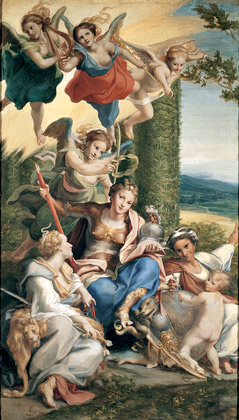Isabella d’Este’s Studiolo
The fashion of studioli, or private studies, small rooms reserved for intellectual activities, spread in the 15th century in the Italian courts, bathed in Humanist culture.
Isabella d’Este, who married Francesco II in 1490, rapidly decided to create a studiolo in a tower of the old Castello di San Giorgio. The work on this project lasted more than twenty years.
She entrusted Mantegna with the first two canvases of the cycle, Parnassus (1497) and Minerva (1502), but considering his work out-of-date, she turned to the most famous painters of the new generation. In vain she solicited Giovanni Bellini, Leonardo da Vinci and Francesco Francia but, in 1505, she obtained only the disappointing painting by Perugino. Lorenzo Costa, appointed court painter at Mantegna’s death (1506), completed the decoration with two canvases delivered between 1506 and 1511.
The Parnassus and Minerva were painted by Mantegna to be placed opposite each other, as demonstrated by the fact that the light comes from the left in the first painting and from the right in the second.
A year after her husband’s death (1519), Isabella transferred her studiolo to the ground floor of the Corte Vecchia. In her new apartment, she added two Allegories executed circa 1530 by Correggio to the old series of paintings.
The layout of the exhibition, while inverting the direction of the itinerary, reproduces the exact layout of Isabella’s second studiolo.
Mantegna and the themes of the Studiolo
The five canvases of the first Studiolo, in the Castello di San Giorgio, all treat the theme of the Victory of Virtues over Vices, but we ignore whether they were part of a general iconographical program fixed from the beginning.
The first picture, commissioned by the Marchesa and completed in 1497, already contains in embryonic form the themes to be developed in the other paintings, namely the triumph of spiritual over earthly love and the celebration of the Arts at the Court of Mantua. The evocation of the amorous relationship of Mars and Venus could be interpreted as an allusion to the couple formed by Francesco II and Isabella, patron and protector of the Muses.
The fact that the second painting, Minerva Expelling the Vices from the Garden of Virtue, completed in 1502, contains ideas and motifs that had obsessed the artist from his beginnings, nonetheless leads one to consider that the artist played a determining role in its conception: the theme of Ignorance as enemy of Virtue, numerous inscriptions in different alphabets, clouds and a tree in human form, or the grotesque personifications of the Vices, chased by the dynamic and majestic warrior goddess.
Antonio Allegri, known as Corregio (Correggio, circa 1489 - Correggio, 1534)
Allegory of Virtues
1528-1530
Canvas; H. 1.48 m; W. 0.88 m
Paris, Musée du Louvre, dép. des arts graphiques, Inv. 5926
© RMN / Hervé Lewandowski









